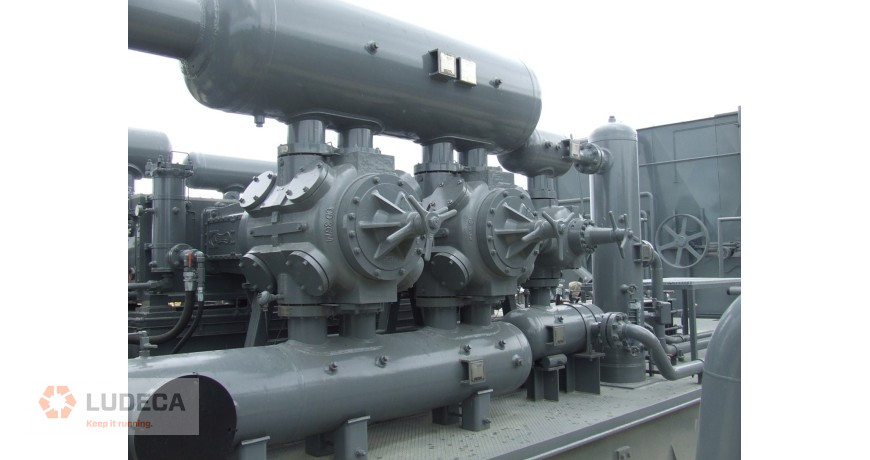When a new technician enters their field of employment, the normal procedure for training is to send them out with older techs that have been doing the job for a while. This is a good old fashioned OJT (On The Job Training). The goal is to have the new tech up to speed quickly, and self sufficient to the point that they can be trusted to work on their own. Maybe, if they pan out, they can be sent later for formal training. Or, at least tested to achieve a certain level of certification. While they are learning the basics for operations and maintenance for their equipment, they will also be told to memorize certain numbers for the adjustments and settings for that same equipment. And this is where the problems start creeping in. Some of those numbers are being given as the specifications, with little to no understanding of how and why those numbers exist. Let’s look at alignment specifications, since that is what Ludeca deals with the most.
I am going to work with natural gas compression, since that is the industry where I have the most experience. The numbers that are always being tossed around are “5 & 5”, as in .005″ for offset and .005″ for angularity. I call that a classic field spec, not a true specification. There are so many things that those numbers do not address.


Here are a few of those things:
- How much thermal growth does each component have for this particular alignment? There are several different engine makes and compressor brands, which all have different models having different growth signatures.
- For instance, an Ariel JGK compressor is advertised by the manufacturer to grow .011″. And some of those can be coupled to a Caterpillar 3400 series engine, which is advertised to grow .015″. With this pairing, the engine would need to be left .004″ lower to compensate for that growth. Some compressors in that same size frame group can be coupled to a Caterpillar 3500 series engine, which grows .019″. That means the engine would actually need to be .008″ lower than the compressor when everything is cold, so that it will be in the correct position when the engine and compressor achieve full thermal growth.
- What is the Diameter of the coupling? While this has nothing to do with the tolerances, it changes everything if you are using the coupling diameter to reference a gap difference against. This comes from the old equation for correcting angularity when using dial indicators. AB/CD where AB is overall length of the movable component divided by the coupling diameter. And if you really worked it out, .005″ TIR on a 36″ coupling was much tighter than on an 8″ coupling. It makes it look like the entire industry was working on a sliding scale of accuracy, and when I asked about it, I was told that it didn’t matter as much on the smaller ones, because they are “cheap”.
- What is the rated speed of the equipment? Speed dictates the tolerances, plain and simple. Think of an engine built 60 years ago. To rev one up above, say, 5000 RPM would scare a lot of people. They would be sure that it would just come apart running that fast! Engines today rev much higher, with no thought being given to those extra few thousand RPMs. It has everything to do with the tolerances during the design and assembly process for the newer engines. We can run them faster because of the tighter specifications. Alignment is the same way. If a traditional Gas Compressor Tech tries to align a gas turbine the same way they would align an engine-driven compressor, it would be a short run and a long (and costly) repair.

And I know a lot of people will say, “but the coupling manufacturer’s specifications say that they can accommodate so much misalignment”. Yes, the specifications do indicate that a certain amount of misalignment can be tolerated, but only for intermittent lengths of time, like a cold start up, to allow the machines to “grow into alignment” with each other as they warm up and are put under load. The flex in a flexible coupling is normally to allow the machinery to run for a while, until full thermal growth and load is achieved which hopefully has everything in correct alignment. Much more important is to look at the internals of the equipment. How much misalignment can those parts withstand for extended periods of time? Certainly, much less than the coupling is built to take.
These were just a few of the things to consider when discussing tolerances and specifications. I was very careful to call the field numbers “Specs”, not specifications. Some of the specs given are just too arbitrary for the level of safety and operational efficiency needed for this type of equipment. Knowing the actual specifications, and even the reasons for them, is too important to ignore. With a little effort, using dealer contacts, available documentation, and a good search engine, correct Specifications can be found.
A Before and After of Alignment on a Caterpillar Engine mated to an Ariel Compressor
Filed under:
Alignment by Chris Greene CRL
